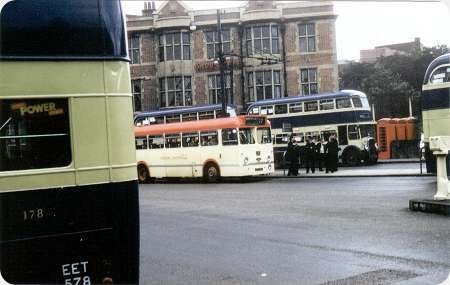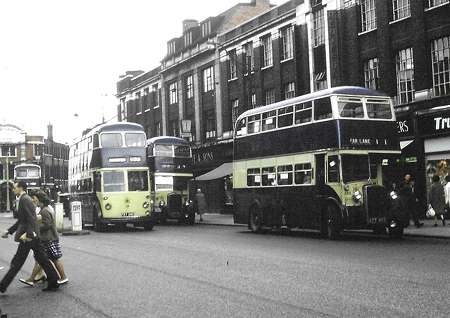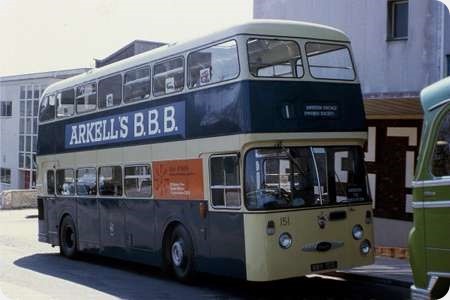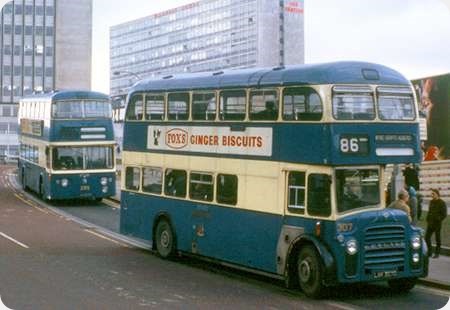Yorkshire Traction – Leyland Tiger Cub – SHE 167 – 1179
Yorkshire Traction Company Ltd
1960
Leyland Tiger Cub PSUC1/1
Metro-Cammell B45F
This Yorkshire Traction Tiger Cub, 1179 (SHE 167) is seen in All Saints’ Square, Rotherham at the loading barrier for service 27 to Barnsley via Hoyland, joint with Rotherham Corporation, in July 1962. The bus is in ‘Tracky’s’ reversed livery of predominantly cream with red trim, reserved for coaches and service buses that could also serve as duplicates on summer outings to the seaside. Having said that, Rotherham was just about as far away from the seaside as you could possibly get, certainly by Yorkshire Traction!
In the background is the impressive building housing Arthur Davy’s shop and café; a table next to a second floor window in this establishment was the perfect place from which to watch the steady comings and goings of the buses and trolleybuses in the Square below.
The other four buses, parts of which are captured in the view, are all Rotherham Corporation Bristol Ks, on various town journeys. Note the ‘Power’ petrol/diesel sticker in the rear window of 178 (EET 578), which was obviously the fuel used by the local corporation; Doncaster’s buses were often seen to carry these as well.
Photograph and Copy contributed by Dave Careless
23/09/19 – 07:13
Rotherham Corporation, just another municipal undertaking which isn’t mentioned much nowadays but it had a fascinating fleet and it covered a wide area. It’s buses could be seen in Barnsley, Doncaster, Chesterfield and Sheffield. It probably suffered from being overshadowed by some of it’s near neighbours!
Chris Barker
24/09/19 – 04:19
Fascinating is an understatement. Mid entrance single deck trolleybuses – many later given new double-deck bodies. A passion for Bristols – maintained until the early ’50s, after the BTC embargo on sales outside the nationalised sector. Modern Bristol Ls sent back to East Lancs (and associated companies) to have double-deck bodies fitted – effectively making them Ks. When that source dried up, Rotherham actively chose to by Crossleys (up to about ’52/’53?) – only for that supply to dry up. Then a stable run of Daimler CVG6s leavened with AEC Bridgemasters and Renowns for low height requirements and finally, before the Fleetline took over, three AEC Regent V 3D2RA – very rare beasts with the 11.3 litre engine. A fascinating fleet indeed.
David Oldfield
25/09/19 – 05:45
Now you’ve whetted my appetite for more Rotherham photos, David!
Chris Hebbron
25/09/19 – 05:46
Some time ago I sent this photograph to a friend Laurie Johnson of Blackpool, who was working as a Rotherham Corporation trolleybus driver when this photo was taken. All these years later, he was still able to identify three of the RCT personnel; the driver with his back to the Tiger Cub was Alf Beeley, and the two inspectors (with hats) were Arthur Heald (left) and Jack Cox (right). Interesting to think that in today’s world, the group of them would probably either be texting or scrolling on I-phones instead of talking to each other , or else drinking coffee from throw-away cups!!
Dave Careless
25/09/19 – 06:59
The 27 was the only route into Barnsley run by a corporation undertaking. Sheffield was the JOC, not the corporation. Some of Rotherham’s East Lancs bodies were by Yorkshire Equipment – who built yachts and school desks! They were renamed East Lancs (Bridlington),
David Oldfield
27/09/19 – 06:21
David mentioned how Rotherham Corporation had worked their way through deliveries of Bristols, Crossleys and Daimlers in the late 40s/50s and into the 60s. This picture rather encapsulates that, with Crossley 185 (EET 885) of the first batch of twelve, with both a Bristol K and a Daimler CVG6 at other stands further down the street. And gliding past, 38 (FET 340), originally number 80, one of the twenty rebodied Daimler trolleys that had shed its original 38-seat single deck East Lancs body for a 70-seat Roe structure in 1956.
Dave Careless
28/09/19 – 05:59
Well done for your photo which does indeed encapsulate my comments. I hail from the leafy southwest of Sheffield but hold Rotherham in great affection. Not only have I relatives in Rotherham but I was, for a short time, organist at All Saints’ (which gives its name to the Square) and, until it closed in July, gave regular recitals at Talbot Lane Methodist Church – just up the hill, opposite the Town Hall.
David Oldfield
28/09/19 – 06:00
Why did Rotherham convert all/some of its single-deck trolleybuses to double-deckers, Dave, an unusual thing to do, let alone single-deck trolleys being rare in themselves?
Chris Hebbron
29/09/19 – 07:01
Chris, by the mid-fifties the small capacity single-deckers were uneconomical to operate and the trolleybus side of things was losing money. With no reserve fund available for wholesale conversion to buses, the new manager, I.O. Fisher, persuaded the Transport Committee in 1955 that double-deck operation would right the ship, which it did. Trolleybuses ran in Rotherham for another ten years before finally being abandoned.
For the record, seventeen of the remaining twenty-four single-deckers eventually made their way to Spain, where they operated successfully for several years. One apparently still survives, preserved in a semi-restored state.
Dave Careless
06/10/19 – 08:04
Not only did Rotherham operate an eclectic fleet of trolley and motor buses the also operated some unique single ended trams on the service to Templeborough on the Sheffield Rotherham boundary the also in pre war years ran through to Sheffield.
Chris Hough
06/10/19 – 08:04
One noticeable aspect in these two pictures taken the same day in 1962 in Rotherham town centre is that the Bristol buses seen in the photograph of the "Tracky" Tiger Cub in All Saints’ Square have the cream paint extended down to below the line of the bottom of the windows on both decks, whereas the Crossley, and the Bristol/East Lancs bus behind it in the view in Effingham Street have been repainted, and the cream paint no longer extends down past the beading below the windows. In the original scheme, a thin black line was added between the blue and the cream, a nice touch, but in the later variation, the lining out was eliminated and the livery was simplified. Cutting costs was the order of the day, and the era of spray painting had begun!
Dave Careless
Quick links to the - Comments Page - Contact Page - Home Page




